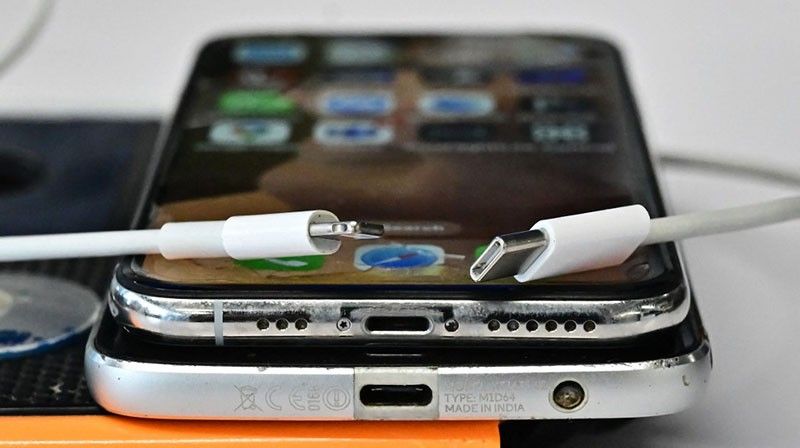Goodbye, Lightning: Timeline of Apple’s shift to USB-C

MANILA, Philippines — In response to European Union regulations, Apple has made a significant change to its newly-revealed iPhone 15 models by replacing the familiar Lightning connector with the widely adopted USB-C port.
This move aligns with the law passed by the EU in 2022, compelling all devices to be compatible with a USB Type-C charging port by late 2024.
USB-C, first introduced in 2014, is an industry-standard connector for transmitting both data and power on a single cable. While this has already been heavily adopted by gadget manufacturers, the transition didn't happen overnight for Apple’s iPhones.
Here’s a look back at the history of the iPhone’s charging solutions and how the iPhone 15’s Type-C port came to be.
2007: 30-pin Dock Connector
The first iPhone model launched in 2007 carries a 30-pin dock connector, the same charging and syncing solution Apple introduced for its third-generation iPod music player in 2003.
The wide 30-pin dock connector, which was non-reversible, became a standard feature from the original iPhone through the iPhone 4S in 2011, and in iPads, it was present from the first-generation up to the third-generation models
2012: Birth of the ‘Lightning’
Five years later, Apple unveiled its then-latest iPhone 5 which carries a new proprietary connector called Lightning.
Featuring only eight pins instead of the 30 on its predecessor, the lightning connector was smaller, reversible and allowed for fast data transfer speeds.
However, there were negative reactions to Lightning’s lack of compatibility with other devices, as at the time, many devices and accessories used a micro-USB connection.
2014: USB-C makes its debut
In 2014, the game-changing USB-C was introduced. The USB-C connector, also known as Type-C, was developed by a group of companies, including Apple, Hewlett-Packard, Intel and Microsoft.
Like iPhone’s Lightning, USB-C is compact and reversible, and it promises high-speed data transfer of up to 10 GB/s and the ability to deliver power at a remarkable 100W. Its goal was to create a universal connector that could be used with a wide range of devices and that would be capable of transmitting data, video and power.
2015-2016: Early adopters shift to USB-C
From 2015 to 2016, USB-C gained traction among suppliers of PCs, smartphones, tablets and other electronics, while devices and accessories featuring USB-C ports started appearing on the market.
Nokia N1 tablet, announced in November 2014 and released in early 2015, was one of the very first consumer devices to feature a USB-C port. Google and Apple then followed with the releases of Chromebook Pixel (March 2015) and 12-inch Macbook (April 2015).
2016-2021: USB-C becomes the standard
Over time, manufacturers have widely adopted USB-C for their smart devices and accessories.
Apple, in particular, expanded its use of USB-C by introducing new iPads and MacBooks that are USB-C compatible. However, Apple continued to rely on the Lightning charger for iPhones, indicating its reluctance to fully transition away from the Lightning connector.
Meanwhile, Samsung, Apple’s biggest competitor in the smartphone scene, started carrying USB-C in its devices in 2016 with the Galaxy Note 7.
2022: EU issues common charger directive
In 2022, a new development emerged that cast a shadow on the future of the Lightning charger.
The European Union took a step toward standardization by issuing a common charger directive for all smartphones. It sought to simplify the charging process for consumers, enhance compatibility across devices and reduce the need for multiple chargers.
The move was also driven by environmental concerns, as a standardized charger was said to help minimize electronic waste and reduce the carbon footprint associated with the production and disposal of charger cables.
The parliament voted overwhelmingly in favor of the change, with 602 votes for and only 13 against. Under the new EU mandate, Apple will have to ship iPhones and iPads with USB-C ports in the region by the end of 2024.
Speculations suggested that Apple might retain the Lightning connectors while introducing a Type-C model specifically designed for the European market. Others have speculated that Apple could sidestep the EU mandate altogether by doubling down on its wireless charging technology.
Apple’s senior VP of worldwide marketing Greg Joswiak, however, made clear that the iPhone will move to USB-C.
“Obviously, we’ll have to comply; we have no choice,” Joswiak confirmed in an interview with The Wall Street Journal's Joanna Stern.
However, he added: "We believe a more environmentally-friendly and customer-centric approach would have been for governments to exercise less prescription in their policies."
2023: iPhone 15 marks end of Lightning era
Complying with the EU’s directive, Apple bid farewell to the Lightning era, a long-standing staple in their devices. This announcement unfolded during the highly anticipated Wonderlust event on September 13, where the new iPhone 15 models took center stage.
Apple did not put too much highlight on the shift to USB-C during the launch, but it disclosed that USB-C charging cables would soon become the standard for both the iPhone 15 lineup and the charging cases of its AirPods Pro devices.
This change, driven by Apple's adherence to the EU directive, is seen to bring practical benefits for consumers, including improved compatibility across devices.
Furthermore, Apple announced during the launch that through the new USB-C, users will now be able to charge devices like Apple Watch or their Airpods directly from the iPhone.
- Latest































